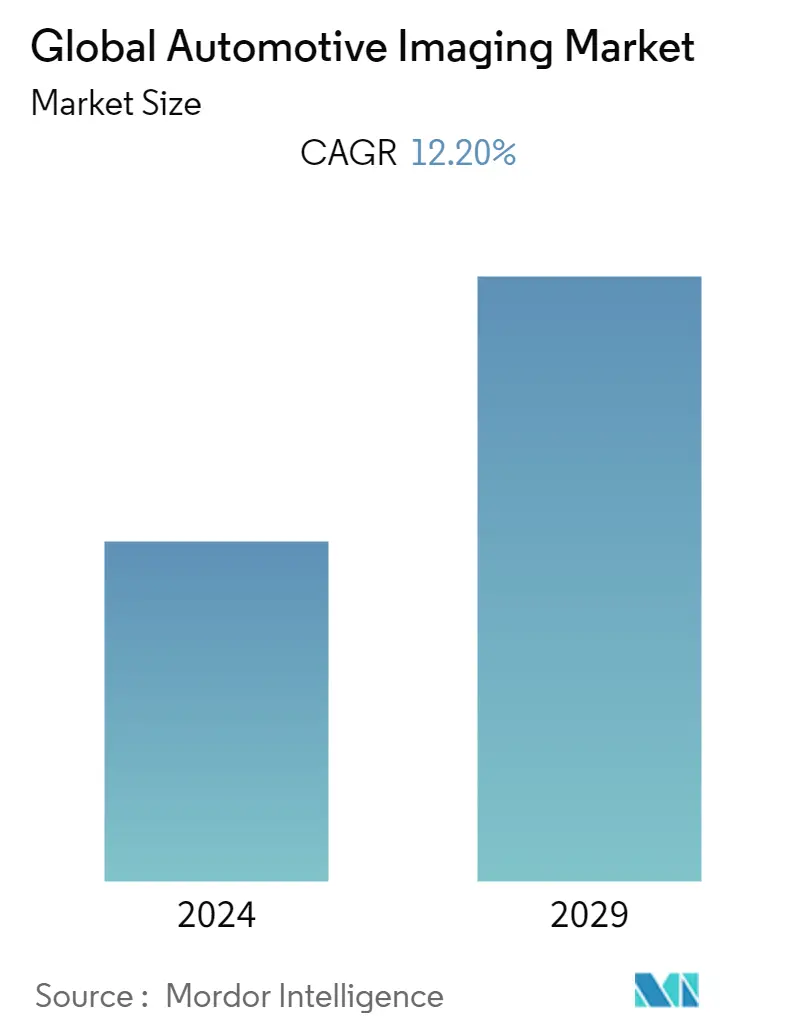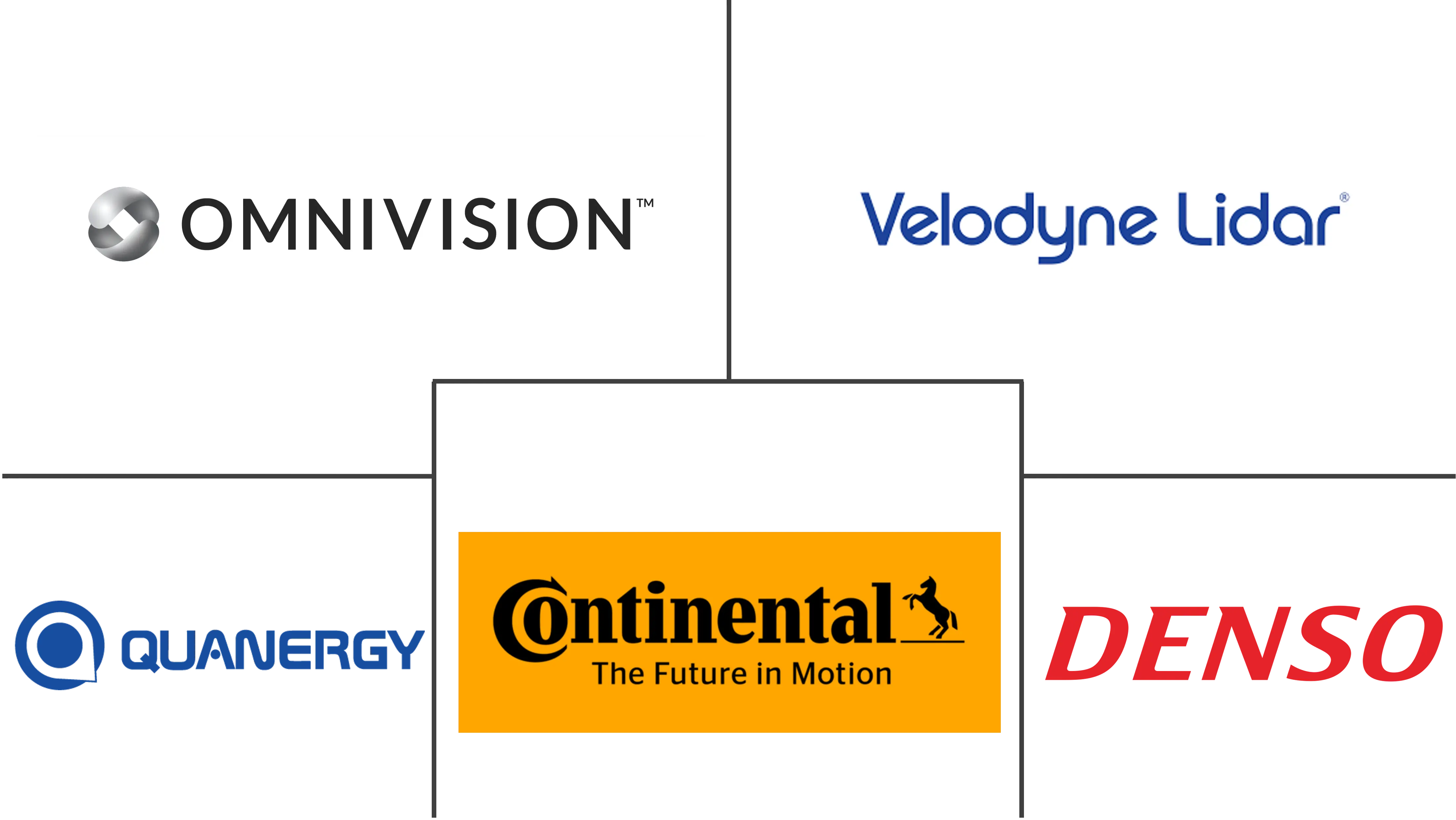Market Size of Global Automotive Imaging Industry

| Study Period | 2019 - 2029 |
| Base Year For Estimation | 2023 |
| CAGR | 12.20 % |
| Fastest Growing Market | Asia-Pacific |
| Largest Market | North America |
| Market Concentration | Medium |
Major Players
*Disclaimer: Major Players sorted in no particular order |
Automotive Imaging Market Analysis
Global Automotive Imaging Market is expected to grow with a CAGR of 12.2% during the forecast period. Automotive imaging combines several image sensors into a single virtual unit with a resolution that exceeds that of the human eye. Horizontal coverage, 3D object resolution, static and dynamic object screening, and real-time data are all things that automotive imaging may assist with. Advanced sensors are creating enormous growth potential in the automotive imaging industry due to the capability of capturing near-real-time images.
- With the growth of technologies in the automotive industry that includes smart automobiles, head-mounted augmented and virtual reality (AR/VR) devices, camera drones, Internet of Things (IoT) appliances, and 3D facial-recognition systems for security and surveillance.
- The demand for Automotive advanced driver assistance systems (ADAS) and electric vehicles is growing. 3D imaging in automotive systems is a critical component of automation, aided by advances in CMOS image sensors.
- The growing trends in the automotive industry toward self-driving cars and electric vehicles are expected to be the critical drivers for newer applications of LiDAR. Self-driving cars increasingly use LiDAR sensors for generating huge 3D maps for 360° vision and for accurate information to assist in self-navigation and object detection.
- COVID-19 has had a significant influence on the global automotive industry. China is the COVID-19 hotspot that has been heavily struck by manufacturing automotive car production. Since all borders were closed, it caused supply chain difficulties. COVID-19 significantly influenced the production and sales of the automotive imaging market.
- However, the automotive imaging market started gaining momentum owing to the mandates by different countries requiring advanced safety features to be installed in the vehicles. The development of new technologies, such as night vision cameras, and the growing e-mobility, is expected to bolster the market growth.
Automotive Imaging Industry Segmentation
The major factors driving the growth of the automotive imaging market are an increase in the number of cars, an increase in the use of ADAS, and an increase in the trend of autonomous cars throughout the world. Companies involved in the production of these sensors spend more money on R&D, which opens up new market potential.
Global Automotive Imaging Market is segmented By Type of Product (CMOS Image Sensors, Camera Modules, Vision Processors, LiDAR, Radar) and by Geography.
| By Type of Product | |||||||||
| CMOS Image Sensors | |||||||||
| |||||||||
| Vision Processors | |||||||||
| |||||||||
|
| By Geography | |
| North America | |
| Europe | |
| Asia-Pacific | |
| Rest of the World |
Global Automotive Imaging Market Size Summary
The global automotive imaging market is poised for significant growth, driven by advancements in image sensor technology and the increasing adoption of smart automotive systems. Automotive imaging integrates multiple image sensors to create high-resolution virtual units, enhancing capabilities such as 3D object resolution and real-time data processing. This technology is becoming increasingly vital in the development of advanced driver assistance systems (ADAS) and electric vehicles, where 3D imaging plays a crucial role in automation. The rise of self-driving cars and the integration of LiDAR sensors for 360° vision are key trends propelling the market forward. Despite challenges posed by the COVID-19 pandemic, which disrupted supply chains and affected production, the market has rebounded due to regulatory mandates for enhanced vehicle safety features and the emergence of new technologies like night vision cameras.
The automotive imaging market is characterized by a moderate level of fragmentation, with several international and regional players such as Continental AG, Denso Corporation, and Omnivision Technologies Inc. actively participating. These companies are focusing on strategic collaborations and technological innovations to expand their market presence and enhance vehicle safety. The Asia-Pacific region, particularly China, is witnessing robust growth due to the increasing adoption of ADAS and the penetration of luxury automotive brands. The market is further bolstered by the rising demand for advanced camera systems in passenger and commercial vehicles, driven by the need for improved safety measures and the growing trend of e-mobility. Key developments, such as collaborations between major players and advancements in AI-based imaging solutions, are expected to continue shaping the market landscape in the coming years.
Global Automotive Imaging Market Size - Table of Contents
-
1. MARKET INSIGHTS
-
1.1 Market Overview
-
1.2 Industry Attractiveness - Porter's Five Forces Analysis
-
1.2.1 Threat of New Entrants
-
1.2.2 Bargaining Power of Buyers
-
1.2.3 Bargaining Power of Suppliers
-
1.2.4 Threat of Substitutes
-
1.2.5 Intensity of Competitive Rivalry
-
-
1.3 Impact of COVID-19 on the Market
-
1.4 Technological Roadmap for Automotive Imaging (2010 to 2030)
-
-
2. MARKET SEGMENTATION
-
2.1 By Type of Product
-
2.1.1 CMOS Image Sensors
-
2.1.2 Camera Modules
-
2.1.2.1 By Application
-
2.1.2.1.1 Rear View
-
2.1.2.1.2 360 Surround
-
2.1.2.1.3 Forward ADAS
-
2.1.2.1.4 Night Vision and Side Mirror Replacement
-
2.1.2.1.5 Dashboard Camera
-
-
-
2.1.3 Vision Processors
-
2.1.4 LiDAR
-
2.1.4.1 By Application
-
2.1.4.1.1 ADAS
-
2.1.4.1.2 Robotic Cars
-
-
-
2.1.5 Radar
-
2.1.5.1 By Application
-
2.1.5.1.1 Corner
-
2.1.5.1.2 Front/ Rear and Others
-
-
-
-
2.2 By Geography
-
2.2.1 North America
-
2.2.2 Europe
-
2.2.3 Asia-Pacific
-
2.2.4 Rest of the World
-
-
Global Automotive Imaging Market Size FAQs
What is the current Global Automotive Imaging Market size?
The Global Automotive Imaging Market is projected to register a CAGR of 12.20% during the forecast period (2024-2029)
Who are the key players in Global Automotive Imaging Market?
Continental AG, Denso Corporation, Omnivision Technologies Inc., Quanergy Systems Inc. and Velodyne LiDAR Inc. are the major companies operating in the Global Automotive Imaging Market.

